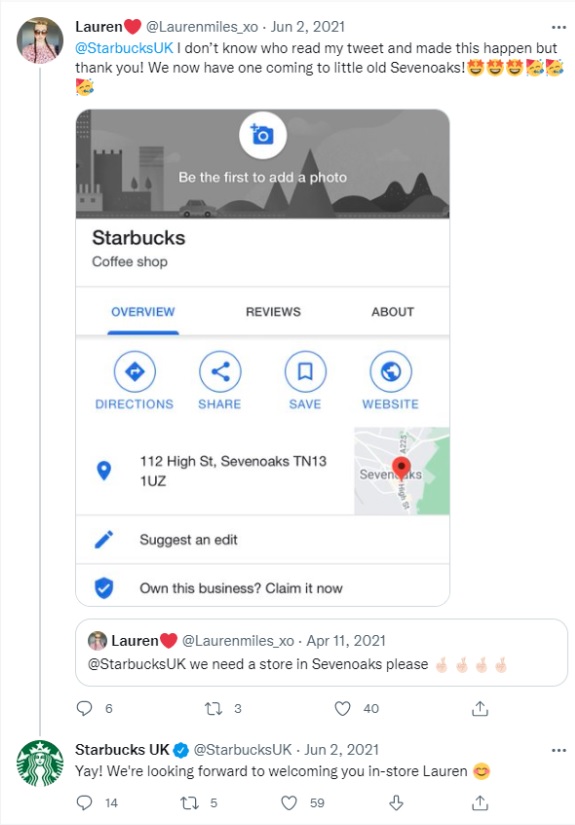While marketing works hard to bring potential customers to your brand, customer service teams have the power to retain them. Here, we’ll look at why you should include customer support in your successful content marketing strategy, and how you can use this collaboration to drive relevant content marketing ideas – and execute them for better results all around.
Why should you include customer support representatives in your content marketing strategy?
Don’t get us wrong, it’s important to set clear lanes and stick within them to avoid treading on toes. But including customer support in your content marketing efforts from the outset means a higher chance of staying on the same page, and less chance of doubling up work.
For example, social media is a platform used for marketing and providing customer support. And in fact, many customers now prefer to go straight to the brand’s social media platform for support. In fact, social media customer service has been on a rise lately thanks to its accessibility and great customer engagement. This means that both teams often have shared ownership and accountability for engagement rate and interactions on social media channels. (If you’re still getting your social channels up and running, try using templates to help you along.)
How does involving customer support representatives in your content marketing strategy benefit your company?
As marketers, we know that the key to executing a successful marketing strategy is consistent and regular high-quality content. But that also means keeping up a steady flow of great ideas – and sometimes, we get stuck! So of course, you should take advantage of all the resources at your disposal.
Your customers are your most invaluable knowledge bank. They are the ones who can answer the following customer questions:
- Are your products useful?
- Do any of them get used in ways that you did not expect?
- Is the price right?
- Why do happy customers come back to you rather than going elsewhere?
And who are the people who connect your loyal customers with your business, including marketing? Your customer service teams.
The importance of aligning the goals of customer service representatives with those of the marketing department
Good communication across the company will always ensure the best customer service results and a strong marketing message that’s maintained across all activities and digital channels. More and more brands are realizing that all parts of their business should be aligned, and many loyal customers now expect a cohesive experience.

So, it’s important to align the goals of the marketing team with the customer service teams and vice versa, to ensure each team’s priorities are in sync. The cost of misalignment can have a detrimental impact on your business, from a decrease in customer loyalty to negative reviews.
How to use customer support representatives’ input in your content marketing plan
When you’re making use of an open communication line between customer support and marketing, why not leverage your customer support team to put you in touch with your clients? Customer-facing members of this team will have the best idea of which clients will be willing to provide testimonials and customer reviews, and for which scenarios they’ll be best suited.

Customer stories are always useful for marketing and promotion. You could even start thinking about longer-term uses. This is also one of the ways to get user-generated content that you include in a blog post, various social media posts, in your email marketing campaigns, or even in a podcast form as audio content.
Depending on your brand, a series of in-depth customer case studies could be effective. These could be written pieces or you could look at employing more creative mediums like video, animation, or infographics.
How to use customer support to drive content marketing ideas
1. Set up a comprehensive knowledge base to reduce support tickets
So far, we have mostly looked at the benefits customer-facing teams can bring to your marketing team. However, a close relationship between marketing and customer support can also significantly benefit the customer care team in their day-to-day work. One such way is by using knowledge-based strategies.
A knowledge base, otherwise known as a help center, should collect a range of answers to problems that your customer base is likely to face. This can be a mix of things like:
- Step-by-step guides
- Frequently asked questions (FAQs)
- How-to’s
- User forums
- Case studies
- Video tutorials
- Troubleshooting tips
It exists as a ‘self-service’, so both new and current customers can quickly and easily solve issues without having to contact the customer support team, thus reducing their support tickets and freeing them up to work on more complex problems.
Your knowledge center should be user-friendly. Start with a high-level design and structure, then you can think about going deeper by topic. You should also prioritize discoverability – researching and investing in a knowledge base software such as LiveAgent will help you here. Having thoroughly planned content is great, but customer satisfaction depends on them being able to find what they need quickly, and easily. Keep search engine indexing in mind, because it has the dual benefit of boosting your site’s search engine optimization (SEO) and cutting out a step for the customer.
Lastly, don’t forget accessibility. This means thinking about clear fonts, breaking up content with headings, subheadings, and bullet points, including alt text if you’re using anything visual, and making sure your valuable content is responsive across desktop, tablet, and mobile devices. You would be surprised how low can your conversion rates drop if your sites aren’t responsive enough on mobile.
2. Produce helpful content for use in a support situation
Once you’ve developed a robust knowledge base, you can start making this a key touchpoint and essential resource for customer acquisition and retention throughout the customer journey. It’s really important that knowledge base content is still on-brand – just as with any other types of content, you produce.
For example, visuals like video content will improve the content in your knowledge base. So, look at what kinds of things are frequently being used or which questions are most searched by customers. Would video content make a process easier to follow? What about a series of simplified diagrams? Could you make it interactive? If you need to create visual content quickly and cost-efficiently, graphic templates can be a great way to start you off.
If you have an idea of the biggest pain points or problems particular types of customers are likely to run into (more on marketing personas further on), pull together answers by topics and create a content strategy around them. Then, pick a marketing channel and start commissioning compelling content that addresses these problems in detail.
Try focusing on a storytelling approach – or incorporate other must-try marketing trends – to keep your customer service content fresh and ahead of the competitor brands out there. By harnessing the power of the knowledge base, you have an opportunity to give your customers comprehensive solutions. If you can, suggest multiple approaches depending on what they might prefer.
As a reward for all this work, your knowledge base also has a role to play in supporting your marketing content creation. Make sure you’re mentioning it in things like blog posts to direct your target audience to see the product in action. In this way, you can also leverage it to convert leads: where you have potentially interested customers directed straight to more detailed, relevant information if they want it.
3. Address the topics that your competitors can’t answer
How to do better than your competitors is an age-old question for any business. The first – and obvious – step is making sure you are answering all of your customer queries, reading all of their reviews, and generally delivering excellent customer service and support.
But the best brands go even further: they anticipate problems. In this way, you can set yourself apart from your competitors. It’s certainly easier said than done, but if you’ve invested time in some of the points discussed so far in this piece, it’s achievable.
By finding and honing in on your specific niche in the market, you can make your content production highly specialized. When you start developing a content marketing program around problems and recommending related content types, you are putting solutions in front of customers that didn’t even know they needed them. And if or when they do need that extra support, they’ll know exactly where to go for it.
And if your competitors start following suit on some of these approaches? Continue developing your knowledge base, keep at your content marketing plan, and keep up the collaboration between marketing and customer support to stay ahead.
4. Create content marketing personas based on customer support representatives insights
If you haven’t used marketing personas before, it’s time to learn about them. You may also hear them referred to as audience personas, customer personas, or buyer personas. They can work for a range of business types – not just ones that sell a specific type of product.
In simple terms, they are fictional characters that represent your target customers. They should provide a detailed description of their individual motivations. You can add demographic details, traits, interests, buying patterns, and main pain points – some brands will include an illustration or use a photographed model to set the persona firmly in your mind.
For example, if you are a car brand, you might have:
- An ‘if it ain’t broke don’t fix it’ is a persona, who won’t upgrade but will be interested in maintenance services
- A ‘big fan of the brand’ who typically buys a new model every two years
- A ‘junior fan’ who has just purchased their first car with you
Alternatively, maybe you have created personas in the past but realized afterward that they weren’t particularly helpful – or at least weren’t as effective as you’d planned.
In either case, what you need to tackle is 1) target audience research and 2) thoroughly understanding what your brand brings to them. As we said earlier in this piece, your customer support team is talking to your customers all the time – more than any other department in your business, including sales teams. So it follows that they are the best people to draw on to create accurate personas. They will have the best insights into how each customer type thinks, and be able to flag extra things you hadn’t thought of. They are also an excellent resource to test and improve the personas, ensuring they stay effective over time.
As a starting point, invite a customer service representative to your planning meetings. Or while you’re researching and drafting up personas, make sure you review relevant customer query logs, or even shadow customer calls or live chats.
5. Understand where and when your customers want to interact
Lastly, when you’ve done all of this research, idea generation, testing, and creation, don’t fall into the trap of a one-size-fits-all approach to customer interaction.
Having a live chat on your site or social media channels is not enough. When customers use an instant messaging service, they expect an instant reply. If that’s not something you can offer, then be very clear about what times of the day or week your help services are available and when the customer can expect to hear back. You can also direct your customers to your knowledge base while they wait. This will reduce the bounce rate and keep prospective customers engaged even when they don’t get to interact with a representative immediately.
Personalization is key to marketing and customer support alike. A personalized experience can be as simple as using your customer’s name but runs all the way through to providing customized responses based on the information they provide, and how they’re reacting in real-time. A sprinkle of personalized content and a friendly approach can do wonders for building a long-lasting customer relationship.
In short, go above and beyond. If you can provide a phone, video call, or face-to-face option, go ahead. Or, if it’s not feasible to have customer support agents available at all times throughout the sales process, enable customers to be able to request a call back during on-call hours. This prevents you from losing the majority of your clients at this stage in the sales funnel. You can also give them opportunities to leave their email addresses or social channels if they prefer this method of communication
In Conclusion
Remember, while a marketing team’s purpose is to acquire customers and engage them throughout the sales cycle, the customer support team is there to improve customer satisfaction and help to reduce customer churn. By working closely together, marketing and customer support can create better customer experiences, as well as more informed, personalized, and focused marketing content.
Improve your marketing communication with LiveAgent
LiveAgent's wide feature set can help you communicate clearly and effectively. Start your free trial and get started today!
Share this article
How to use customer incentives
Would you like to stimulate customer purchases? Read about how to use customer incentives and improve your customer service with LiveAgent.
Customer service vs customer support
Customer service and customer support are often used interchangeably. Use our guide to learn the difference between the two.
Relationship marketing: How to connect with your customers
First, there’s the initial spark of wonder. Then, there’s the commitment as you settle into a routine and plan a future. However, there’s also competition.
Why customer support and loyalty initiatives are worth the investment
Make your customer feel comfortable returning to your company the next time they’re in need. Read more about the benefits of providing customer support.

 Български
Български  Čeština
Čeština  Dansk
Dansk  Deutsch
Deutsch  Eesti
Eesti  Español
Español  Français
Français  Ελληνικα
Ελληνικα  Hrvatski
Hrvatski  Italiano
Italiano  Latviešu
Latviešu  Lietuviškai
Lietuviškai  Magyar
Magyar  Nederlands
Nederlands  Norsk bokmål
Norsk bokmål  Polski
Polski  Română
Română  Русский
Русский  Slovenčina
Slovenčina  Slovenščina
Slovenščina  简体中文
简体中文  Tagalog
Tagalog  Tiếng Việt
Tiếng Việt  العربية
العربية  Português
Português 











